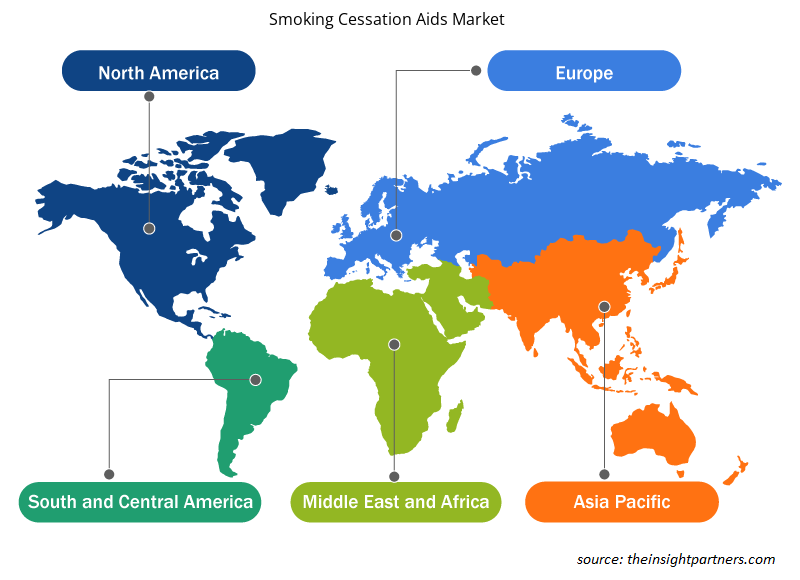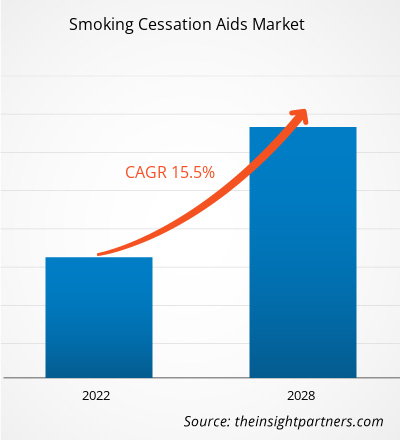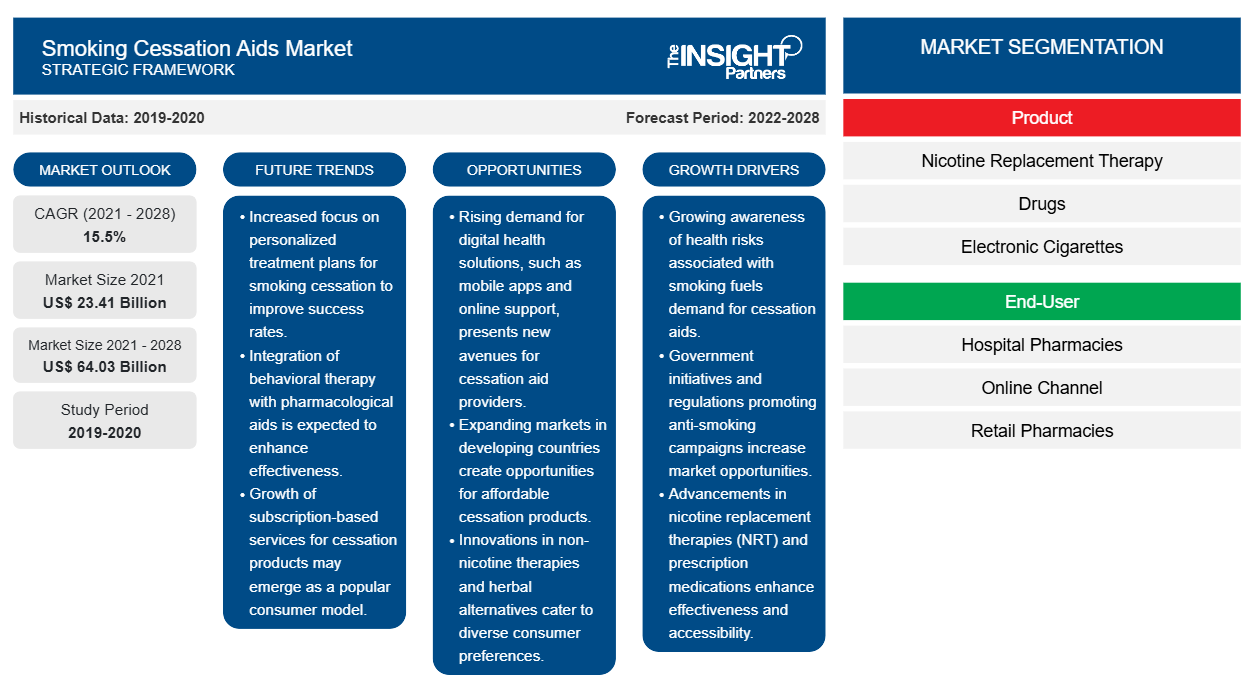Si prevede che il mercato degli aiuti per smettere di fumare raggiungerà i 64.032,30 milioni di dollari entro il 2028, rispetto ai 23.413,08 milioni di dollari del 2021. Si stima che il mercato crescerà con un CAGR del 15,5% dal 2021 al 2028.
I fattori chiave che stanno guidando la crescita di questo mercato di ausili per la cessazione del fumo sono la crescente dipendenza dal fumo di tabacco, il crescente numero di campagne per ridurre il fumo e la dipendenza dal tabacco. Tuttavia, è probabile che i costi crescenti per lo sviluppo di terapie sostitutive della nicotina frenino in una certa misura la crescita del mercato negli anni a venire.
Approfondimenti di mercato
Aumento della dipendenza dal fumo di tabacco
La nicotina è una sostanza altamente assuefacente presente nella pianta del tabacco. È stato dimostrato che fumare tabacco è pericoloso in tutte le sue forme, in quanto può causare condizioni di salute croniche, malattie prevenibili, decessi e disabilità. Secondo l'Organizzazione mondiale della sanità (OMS), i disturbi correlati al fumo causano circa 435.000 decessi all'anno negli Stati Uniti, il che equivale a circa 1 su 5 dei decessi totali nel paese. Secondo i Centers of Disease Control and Prevention (CDC), nel 2018, quasi 40 milioni di adulti negli Stati Uniti hanno fumato sigarette. Inoltre, circa 4,7 milioni di studenti delle scuole medie e superiori hanno utilizzato almeno un prodotto del tabacco e circa 1.600 giovani di età inferiore ai 18 anni negli Stati Uniti hanno fumato la loro prima sigaretta. Ogni anno, quasi mezzo milione di pazienti muoiono a causa di malattie causate dal fumo. Il governo degli Stati Uniti spende circa 225 miliardi di dollari per l'assistenza medica per curare i pazienti che soffrono di condizioni associate al fumo negli Stati Uniti. Pertanto, la prevalenza del fumo di tabacco è elevata in vari paesi del mondo.
Personalizza questo report in base alle tue esigenze
Riceverai la personalizzazione gratuita di qualsiasi report, comprese parti di questo report, o analisi a livello nazionale, pacchetto dati Excel, oltre a usufruire di grandi offerte e sconti per start-up e università
- Scopri le principali tendenze di mercato in questo rapporto.Questo campione GRATUITO includerà analisi di dati che spaziano dalle tendenze di mercato alle stime e alle previsioni.
Lo scenario è simile in vari paesi europei e asiatici. Grecia, Bulgaria, Francia e Croazia comprendono le popolazioni con un elevato consumo di tabacco in Europa. Secondo l'Institute of Health Metrics and Evaluation, il fumo è una dipendenza molto comune in Europa, poiché oltre il 20% degli adulti di età superiore ai 15 anni fuma ogni giorno. Inoltre, secondo la World Population Review, i tassi di fumo più elevati si riscontrano nel sud-est asiatico e nei Balcani in Europa. La WPR suggerisce anche che in vari paesi del sud e sud-est asiatico, i tassi di fumo tendono a essere elevati tra gli uomini. Ad esempio, in Indonesia, il tasso di fumo tra gli uomini era del 76,20% nel 2018. Pertanto, il crescente numero di popolazioni di fumatori in tutto il mondo guida la crescita del mercato globale degli aiuti per smettere di fumare.
Approfondimenti basati sui prodotti
In base al prodotto, il mercato degli aiuti per smettere di fumare è segmentato in terapia sostitutiva della nicotina, farmaci, sigarette elettroniche e altri. Le sigarette elettroniche sono considerate un'alternativa sana alle sigarette di tabacco e si stima che saranno il segmento in più rapida crescita nel periodo di previsione. Le sigarette elettroniche sono un'alternativa efficace per ridurre le condizioni di salute associate al tabacco, mentre le terapie sostitutive della nicotina funzionano meglio per smettere di fumare. Le sigarette elettroniche sono una potenziale minaccia per le sigarette a base di tabacco. Inoltre, il consumo di sigarette elettroniche è meno dannoso rispetto alle sigarette normali, niente fumo e nessun rischio di fumo passivo, consentito l'uso anche in luoghi non fumatori, diversi livelli di nicotina e disponibilità in vari gusti sono alcuni dei principali fattori trainanti per il mercato delle sigarette elettroniche. Inoltre, la crescente popolarità delle sigarette elettroniche supportata dalla sua caratteristica elettronica è il fattore principale che contribuisce alla sua crescente domanda.
Informazioni basate sull'utente finale
In base all'utente finale, il mercato degli aiuti per smettere di fumare è segmentato in farmacie ospedaliere, canale online, farmacie al dettaglio e altri utenti finali. È probabile che il segmento delle farmacie al dettaglio deterrà la quota maggiore del mercato nel 2021, tuttavia si prevede che il segmento del canale online registrerà il CAGR più elevato del mercato durante il periodo di previsione.
I principali attori come Pfizer Inc.; GlaxoSmithKline plc.; Dr. Reddy's Laboratories; Johnson and Johnson Services, Inc.; Cipla Inc.; Perrigo Company plc; Bausch Health Companies Inc.; Glenmark; NJOY; e Juul Labs adottano diverse strategie organiche e inorganiche per migliorare i loro ricavi e la loro posizione di mercato. Ad esempio, a luglio 2020, Dr Reddy's Laboratories ha lanciato le pastiglie di Nicotine Polacrilex da banco sul mercato americano nei dosaggi da 2 mg e 4 mg. Inoltre, a novembre 2020, Perrigo Company plc ha completato il quarto anno della sua campagna "Smettere è meglio" in collaborazione con l'American Cancer Society (ACS).
Approfondimenti regionali sul mercato degli aiuti per smettere di fumare
Le tendenze regionali e i fattori che influenzano il mercato degli aiuti per la cessazione del fumo durante il periodo di previsione sono stati ampiamente spiegati dagli analisti di Insight Partners. Questa sezione discute anche i segmenti e la geografia del mercato degli aiuti per la cessazione del fumo in Nord America, Europa, Asia Pacifico, Medio Oriente e Africa e America meridionale e centrale.

- Ottieni i dati specifici regionali per il mercato degli aiuti per smettere di fumare
Ambito del rapporto di mercato sugli aiuti per smettere di fumare
| Attributo del report | Dettagli |
|---|---|
| Dimensioni del mercato nel 2021 | 23,41 miliardi di dollari USA |
| Dimensioni del mercato entro il 2028 | 64,03 miliardi di dollari USA |
| CAGR globale (2021 - 2028) | 15,5% |
| Dati storici | 2019-2020 |
| Periodo di previsione | 2022-2028 |
| Segmenti coperti | Per Prodotto
|
| Regioni e Paesi coperti | America del Nord
|
| Leader di mercato e profili aziendali chiave |
|
Smettere di fumare aiuta la densità degli attori del mercato: comprendere il suo impatto sulle dinamiche aziendali
Il mercato degli aiuti per smettere di fumare sta crescendo rapidamente, spinto dalla crescente domanda degli utenti finali dovuta a fattori quali l'evoluzione delle preferenze dei consumatori, i progressi tecnologici e una maggiore consapevolezza dei benefici del prodotto. Con l'aumento della domanda, le aziende stanno ampliando la loro offerta, innovando per soddisfare le esigenze dei consumatori e capitalizzando sulle tendenze emergenti, il che alimenta ulteriormente la crescita del mercato.
La densità degli operatori di mercato si riferisce alla distribuzione di aziende o società che operano in un particolare mercato o settore. Indica quanti concorrenti (operatori di mercato) sono presenti in un dato spazio di mercato in relazione alle sue dimensioni o al valore di mercato totale.
Le principali aziende che operano nel mercato degli ausili per smettere di fumare sono:
- Pfizer Inc.
- Società anonima GlaxoSmithKline.
- Laboratori del Dr. Reddy
- Johnson and Johnson Services, Inc.
- Cipla Inc.
Disclaimer : le aziende elencate sopra non sono classificate secondo un ordine particolare.

- Ottieni la panoramica dei principali attori del mercato degli aiuti per smettere di fumare
Mercato degli aiuti per smettere di fumare – per prodotto
- Terapia sostitutiva della nicotina
- Droghe
- Sigarette elettroniche
- Altri
Mercato degli aiuti per smettere di fumare – per utente finale
- Farmacie Ospedaliere
- Canale online
- Farmacie al dettaglio
- Altri
Mercato degli aiuti per smettere di fumare – per area geografica
America del Nord
- NOI
- Canada
- Messico
Europa
- Francia
- Germania
- Italia
- Regno Unito
- Spagna
- Resto d'Europa
Asia Pacifico (APAC)
- Cina
- India
- Giappone
- Australia
- Corea del Sud
- Resto dell'Asia Pacifica
Medio Oriente e Africa (MEA)
- Sudafrica
- Arabia Saudita
- Emirati Arabi Uniti
- Resto del Medio Oriente e Africa
America del Sud e Centro (SCAM)
- Brasile
- Argentina
- Resto del Sud e Centro America
Profili aziendali
- Pfizer Inc.
- Società anonima GlaxoSmithKline.
- Laboratori del Dr. Reddy
- Johnson and Johnson Services, Inc.
- Cipla Inc.
- Perrigo Company plc
- Società farmaceutica Bausch Health Inc.
- Glenmark
- DIVERTITI
- Laboratori Juul
- Analisi storica (2 anni), anno base, previsione (7 anni) con CAGR
- Analisi PEST e SWOT
- Valore/volume delle dimensioni del mercato - Globale, Regionale, Nazionale
- Industria e panorama competitivo
- Set di dati Excel
Report recenti
Testimonianze
Motivo dell'acquisto
- Processo decisionale informato
- Comprensione delle dinamiche di mercato
- Analisi competitiva
- Analisi dei clienti
- Previsioni di mercato
- Mitigazione del rischio
- Pianificazione strategica
- Giustificazione degli investimenti
- Identificazione dei mercati emergenti
- Miglioramento delle strategie di marketing
- Aumento dell'efficienza operativa
- Allineamento alle tendenze normative





















 Ottieni un campione gratuito per - Mercato degli aiuti per smettere di fumare
Ottieni un campione gratuito per - Mercato degli aiuti per smettere di fumare